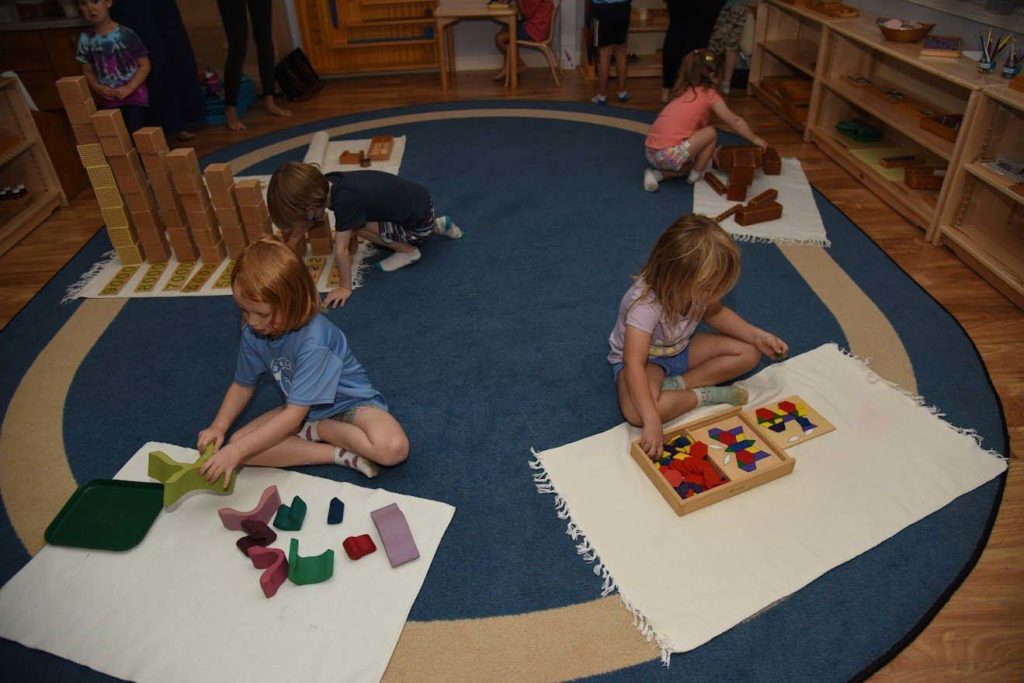"We teachers can only help the work going on, as servants wait upon a master."
- Maria Montessori







"We teachers can only help the work going on, as servants wait upon a master."
- Maria Montessori
Montessori at Home
Expand the learning experience to your home. Find out little ways to reinforce our methods in your child’s routine.
Bringing the Montessori principles to your home is a healthy way to reinforce the values and real-life skills taught in our classrooms.
If you’re willing to connect with your child by being part of – and assisting – their learning experiences, you’ll witness their emotional and intellectual growth on a deeper level. This kind of parental engagement will enable your child to truly embody Montessori principles , becoming commendable students, sons, and daughters.
Lucky for you, applying our core values to your child’s day-to-day at home is simpler than you’d think. All it takes is a few spatial and behavioral changes to your family’s personal environment and homelife, and your child will be excelling in organization and self-reflection in no time, on their way to becoming an outstanding citizen of the world.
“Lorem ipsum dolor sit amet, consectetur adipiscing elit. Phasellus leo dui, varius sed pulvinar nec, viverra viverra tortor”
Molding a Prepared Environment
We believe that every child has an unlimited potential just waiting to be discovered and engaged. In order to unlock these abilities, a certain amount of freedom must be provided. By observing how your child interacts with certain items, you’ll slowly realize where their strengths lie.
At our school, your child will have classes in carefully designed classrooms, where toys, books, and other items are placed in specific locations. Key items are placed at an eye level and within reach, while toys can rotate and switch places from time to time to encourage exploration.
For a Montessori at Home experience, you must organize your home according to these same standards, replicating and stretching the classroom environment.
Organizing the Space
In the Montessori Prepared Environment, everything must have its place. A tight sense of organization will help your child learn where everything goes, and, most importantly: that if they take something, they should replace it in the same spot. This is essential for the child’s recognition of responsibility.
Limiting toy choices and placing key items on open shelves -always at an eye level – will improve the overall feel of the space and enable your child to interact with everything available.
This type of care also helps your child understand that the space’s natural state is clean and organized. If children initially enter a disorganized space, they feel no responsibility for keeping it arranged. Also, to go the extra mile, you can consider eventually separating toys, books, and puzzles by subject.
Let’s reinforce some key points of space organization when teaching Montessori at Home:
1. Keep Items at an Eye Level
In order to explore their preferences and go through a self-guided learning journey, your child must have a selected number of materials, toys, or books within their reach. They’ll eventually get used to getting things for themselves and no longer require parents’ assistance in tasks they can execute alone.
2. Provide Child-Sized Tools
To truly get in tune with the space, your child must feel it is shaped for them. One of the ways you can achieve that is to provide several child-sized objects. Small chairs, tables, shelves, and even brooms and cloths, are all welcome. These will make your child feel more comfortable and active.
Freedom to determine one’s actions is a key Montessori value. The presence of these tools helps to develop a strong sense of autonomy, since children will be able to move furnishings, grab objects, and even clean the environment without any assistance.
3. Rotate Items
“Lorem ipsum dolor sit amet, consectetur adipiscing elit. Phasellus leo dui, varius sed pulvinar nec, viverra viverra tortor”
Bedroom
This is probably the room every kid spends most of their time in, so it definitely should be treated with extra care.
The bedroom can be a place to relax, study, play around, get dressed, etc. However, just because your kid can do all of these things inside the bedroom, doesn’t mean the environment has to be overwhelming. Preventing clutter is essential to minimizing distractions while promoting independence and productivity.
Showcase of Personality
In their bedroom, your child must feel comfortable and relaxed, but proactive when necessary. Artwork and posters on the walls are encouraged, although not in excess. Letting your child pick the paint color is also a good way to help them feel ownership over their environment.
How To Store and Organize
For clothes, store them in low drawers and baskets, always within reach. Keep the winter clothes out of sight in the summer and vice-versa. This avoids possible parental interference on how to dress which, consequently, helps preserve the confidence of your child.
Toys, books, and games should be in easy reach as well. Prioritize low shelves instead of boxes. Separate them by category if you like, but never provide items all at once, in order to facilitate the rotation process.
Kitchen
The kitchen is usually a place parents try to keep their children out of. But for a child growing up with a strong sense of autonomy propelled by the Montessori method, that wouldn’t make any sense. Your child should be free to traverse the kitchen, as well as access certain items from it.
How To Store and Organize
A stool near the sink will encourage your child to wash their hands, as well as vegetables and fruits. Child-sized tables and chairs are also encouraged, so your child can sit more comfortably or even prepare their own snacks with ease.
Storing healthy snacks and water low in the refrigerator or pantry will encourage your child to eat healthy and stay hydrated – all by themselves. Plates, cups, and spoons should also be in low cabinets or drawers. Depending on their age, habituate your kid to only put utensils back if they’re clean while disposing of food leftovers in the trash.
Montessori Parenting
Being a Montessori-driven parent is actually easier than you’d think. Once you put in the effort to construct the right environment and take notes on your child’s behavior, preferences, and skills, the rest of the process develops almost by itself. Your child will depend only on occasional moments of proper guidance to keep growing on an intellectual and human level.
Coming up, we’ll help you understand some key roles you must fulfill as a parent for implementing Montessori at Home.
Much Observation, Little Interference
The parents, just like the Montessori teacher, must act as guides and observers above all else, always avoiding any unneeded interference or opposition.
Observe your child as they interact with all the materials available, keeping note of things like time spent in each activity, level of interest, and things said during it. Doing that, you’ll soon discover what entices your child’s curiosity and what doesn’t.
Use this information to enable your child to pursue their interests, acquiring extra material on specific topics and imposing challenges, always keeping things fresh.
Practice Real-Life Skills
Acquiring real-life skills, which is often accomplished through hands-on tasks, is crucial to the whole Montessori experience.
The appreciation for autonomy is presented very early on in our method. And make no mistake, such value can only be absorbed by doing it yourself. With the help of the prepared environment setting, your child can start practicing skills ranging from cleaning their environment and utensils to washing fruits and vegetables before consumption.
They can even assist a younger brother/sister with a couple of chores or take the family’s dog for a walk.
Keep Them Focused
Children are naturally curious and eager to learn. However, their energy can divert to other activities before they complete a task they’re currently working on.
To make sure your child won’t give up on tasks before they’re accomplished, set them up with materials, toys, and other things they’ve shown previous interest in. Put them in an adequate place to work on the task at hand, give them some time, and observe.
They tend to become far more productive that way, but if not, take notes about the experience and try to find out why they lost interest in doing the task in that scenario.
Provide Inner Motivation
Part of the guidance parents and teachers provide includes recognizing the child’s efforts. Verbal praise is always valued, whether it’s during the learning process, after completing home chores, or doing anything parents would find admirable and praiseworthy. This type of verbal reward could be given after the completion of any tasks, no matter the quality of the final product – the task’s done, and that’s what matters.
External rewards such as candy, gold stars, or even money, is not something we’d recommend. We believe that the child must (and eventually will) find honor and pleasure in the work itself, and the verbal praise – given in moderation – would only be a plus to the experience.
The secret is to keep the motivation coming from within. Your child must see the tasks not only as work, but as challenges waiting to be overcome.

Where to Next? After Care
MSC’s Aftercare program provides care for enrolled students when the school day is over. It’s available on any day on which the school is open, with the exception of the last day of school.


